Content
- 1 How and from what amaranth flour is made
- 2 The composition and calorie content of amaranth flour
- 3 Why is amaranth flour useful?
- 4 Amaranth flour during pregnancy and breastfeeding
- 5 Amaranth flour for weight loss
- 6 How to consume amaranth flour
- 7 Is amaranth flour good for diabetes
- 8 The use of amaranth flour in cosmetology
- 9 What can be made from amaranth flour
- 10 Harm of amaranth flour and contraindications
- 11 Conclusion
- 12 Reviews
The benefits and harms of amaranth flour are due to the content of trace elements, useful amino acids, polyunsaturated fatty acids, the properties of which are widely known. She recently appeared on store shelves, but has already become popular among those who look after their health. It is recommended for those on a gluten-free diet.
How and from what amaranth flour is made

It is obtained from a representative of the family of the same name - caudate amaranth. For the first time as a culture, it began to be cultivated on the North American continent by the ancient people - the Aztecs, who knew about its benefits. The natives used cereals from amaranth grains, ground them to make bread.
The Europeans called the unfamiliar culture "the wheat of the Aztec people", "the bread of the Incas." Its properties are still of interest to scientists. Currently, amaranth has spread as a weed throughout Europe and Asia. In Russia, the plant does not ripen, so flour is an imported product. Industrial production is carried out in North and Central America, India.
Amaranth is a beautifully flowering tall plant that has many benefits in its leaves and seeds. Very small flowers are collected in long cherry-colored panicles, hanging down picturesquely. In autumn, seeds are formed in them, which are then used for grinding. Each plant produces over 500,000 grains. True, they are rather small: 2.5 thousand seeds per 1 g.
The composition and calorie content of amaranth flour
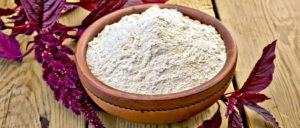
Why has it become popular recently, is there any harm from its use? These questions will be answered by comparing the product with the wheat analogue, from which most bakery products are made.
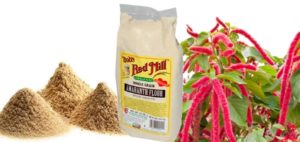
It contains proteins, fats and carbohydrates. Depending on the quality of flour, proteins are contained in an amount from 9 to 13 g per 100 grams, which is close to the indicators of wheat. But their set of amino acids is different.
For example, amaranth grain powder contains 2 times more of such an essential amino acid as lysine than wheat. Lysine is not synthesized by the human body, but tends to participate in metabolism. Most of the amaranth proteins are globulins, albumins, the benefits of which have been proven for a long time.
There are a little more carbohydrates in wheat flour, which also speaks of the advantages of amaranth (the indicator ranges from 61 g to 68 g per 100 g of substance), calorie content - 344 kcal. And fat is 2 times more than in the usual to us. But there is no harm from them.
Why is amaranth flour useful?
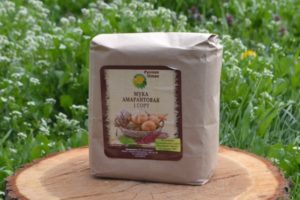
The benefits of amaranth seed flour are due to the presence of the following beneficial features:
- A high content of amino acids, primarily lysine. It, in combination with other amino acids, prevents the formation of harmful substances that cause vascular blockage. Lysine is involved in protein synthesis, and since it is not synthesized by the body, its supply must be maintained with food.
- Squalene is helpful in regulating cholesterol levels. Scientists have discovered its ability to protect cells from the effects of toxins that harm, poisoning the body.
- Amaranth flour can be used to treat celiac disease, that is, those who suffer from gluten (gluten) intolerance. It is known to be found in both wheat and rye flour. For patients with such a digestive disorder, gluten causes irreparable harm. This substance does not contain gluten.
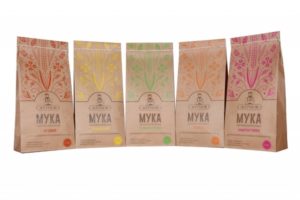
The benefits of amaranth flour for the body are due to the high content of trace elements, vitamins and other substances, the properties of which have been proven by scientists and nutritionists.
Amaranth flour during pregnancy and breastfeeding
During pregnancy, it is beneficial to add it to food due to its high amino acid content. They play an important role in the metabolism, formation and development of the fetus.
Amaranth flour is useful for children. When breastfeeding, you can eat baked goods from this component or add it to vegetable soups, mashed potatoes, and main dishes.
The harm from this unique product, like an allergy to amaranth flour, has not yet been identified.
Amaranth flour for weight loss
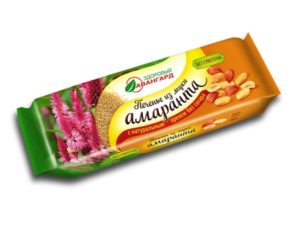
Amaranth flour is recommended on the Ducan diet, it is included in the permitted products. Its benefits are due to its high protein content and total absence of gluten. That is, it has the properties that are recommended for this diet.
How to consume amaranth flour
Not everyone has heard of the existence of this useful product, so many do not know how to use it.
Amaranth flour has a bright nutty flavor that is passed on to dishes.
Can be used neat when baking baked goods. This product can be mixed with regular flour in a 1: 1 ratio for soft and fluffy baked goods.
It can also be added to sauces.
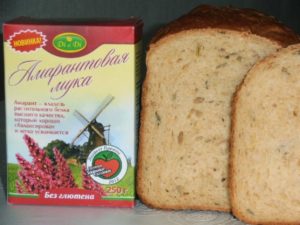
Is amaranth flour good for diabetes
Since a metabolic disorder is observed in diabetes mellitus, first of all, patients are recommended products that have a useful ability to restore this lost property.
The use of amaranth flour in cosmetology
This ingredient is used in the preparation of facial cosmetics. Masks are useful for those who want to restore the lost youth of the skin.

Amaranth flour face mask:
- 2 tablespoons of amaranth seed powder;
- 1 tablespoon sour cream;
- 1 drop of vitamin E oil solution.
Application:
- Stir everything until smooth.
- Apply the mass to cleansed face.
- After 20 minutes, wash off with cold water.
This mask is good for restoring aging skin: it will return freshness to the face and smooth out wrinkles.
What can be made from amaranth flour
You can prepare from this product:
- bread;
- cupcakes;
- pancakes and pancakes;
- fruit charlotte;
- biscuit;
- cakes for cakes;
- pita.
It will be beneficial if you add it instead of wheat during the preparation of cheese cakes, casseroles, cutlets, sauces.

Harm of amaranth flour and contraindications
The dietary remedy brings significantly more benefits than harm to the body. But, like any other product, it has contraindications.
For diseases of the kidneys, liver and gallbladder, any chronic disease, you should consult a doctor before use.
With hepatosis, amaranth flour should be used with caution.
Conclusion
The benefits and harms of amaranth flour have been scientifically proven and substantiated by its long-term use in food by the inhabitants of India and the Mexicans. The uniqueness of the product is confirmed by the presence of amino acids and light polyunsaturated fats, which are useful for both young children and the elderly.
The nutritionist tells about the benefits:

